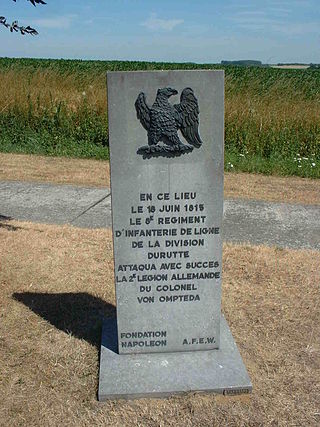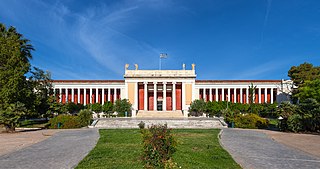

An Attic funerary relief, sometimes also known as the Mithridates funerary relief is displayed at the National Archaeological Museum of Athens (NAMA), with the inventory number 4464. Its date is uncertain.


An Attic funerary relief, sometimes also known as the Mithridates funerary relief is displayed at the National Archaeological Museum of Athens (NAMA), with the inventory number 4464. Its date is uncertain.
The Pentelic marble relief consists of two plates and there must have been a third piece on the left hand side, containing at least the tail of the horse. The central figure of the relief is a horse moving to the right, with its head pulled upwards away from the right edge of the relief. A portion of the horses nose is missing, the only substantial damage to the piece. Its left foreleg is raised and bent, the right is stretched out and planted firmly in the ground. The hind legs reinforce the horse's position, the left hind leg is in very low relief, only barely extending out of the surface. On the horse's back is a panther pelt, which is attached around its front. At the front, to its left, stands a stable boy who reaches up to strike the horse with a whip, as the pained posture of the horse's head makes clear. The boy wears a chiton. His hair is cut short, but the pattern of the locks indicates that he is an exotic foreigner. It is probably that he is an African slave, most likely from Ethiopia.
Arabs and Africans were depicted in Greek art from the fourth century BC. In addition to this example, the 2-metre-high (6.6 ft), 1.9-metre-wide (6.2 ft) relief found in 1948 near the Larisa metro-station must date to near the end of the fourth century BC. Other datings assign the relief to the first century BC. If one takes the earlier dating it is assumed that the relief belonged to a large grave naiskos; supporters of the later dating often connect it with the funerary monument of King Mithridates VI Eupator of Pontus.

A stele, from Greek στήλη, stēlē, plural στήλαι stēlai, is a stone or wooden slab, generally taller than it is wide, erected in the ancient world as a monument. The surface of the stele often has text, ornamentation, or both. These may be inscribed, carved in relief, or painted.

The National Archaeological Museum in Athens houses some of the most important artifacts from a variety of archaeological locations around Greece from prehistory to late antiquity. It is considered one of the greatest museums in the world and contains the richest collection of Greek Antiquity artifacts worldwide. It is situated in the Exarcheia area in central Athens between Epirus Street, Bouboulinas Street and Tositsas Street while its entrance is on the Patission Street adjacent to the historical building of the Athens Polytechnic university.

The study of Roman sculpture is complicated by its relation to Greek sculpture. Many examples of even the most famous Greek sculptures, such as the Apollo Belvedere and Barberini Faun, are known only from Roman Imperial or Hellenistic "copies". At one time, this imitation was taken by art historians as indicating a narrowness of the Roman artistic imagination, but, in the late 20th century, Roman art began to be reevaluated on its own terms: some impressions of the nature of Greek sculpture may in fact be based on Roman artistry.

The Heraion of Samos was a large sanctuary to the goddess Hera, on the island of Samos, Greece, 6 km southwest of the ancient city of Samos. It was located in the low, marshy basin of the Imbrasos river, near where it enters the sea. The late Archaic temple in the sanctuary was the first of the gigantic free-standing Ionic temples, but its predecessors at this site reached back to the Geometric Period of the 8th century BC, or earlier. The ruins of the temple, along with the nearby archeological site of Pythagoreion, were designated UNESCO World Heritage Sites in 1992, as a testimony to their exceptional architecture and to the mercantile and naval power of Samos during the Archaic Period.

The Temple of Ares was a Doric hexastyle peripteral temple dedicated to Ares, located in the northern part of the Ancient Agora of Athens. Fragments from the temple found throughout the Agora enable a full, if tentative, reconstruction of the temple's appearance and sculptural programme. The temple had a large altar to the east and was surrounded by statues. A terrace to the north looked down on the Panathenaic Way. The northwest corner of the temple overlays one of the best-preserved Mycenaean tombs in the Agora, which was in use from ca. 1450-1000 BC.

Etruscan art was produced by the Etruscan civilization in central Italy between the 10th and 1st centuries BC. From around 750 BC it was heavily influenced by Greek art, which was imported by the Etruscans, but always retained distinct characteristics. Particularly strong in this tradition were figurative sculpture in terracotta, wall-painting and metalworking especially in bronze. Jewellery and engraved gems of high quality were produced.

The Archaeological Museum of Eretria is a museum in Eretria, in the Euboea regional unit of Central Greece.

The Harpy Tomb is a marble chamber from a pillar tomb that stands in the abandoned city of Xanthos, capital of ancient Lycia, a region of southwestern Anatolia in what is now Turkey. Built in the Persian Achaemenid Empire, and dating to approximately 480–470 BC, the chamber topped a tall pillar and was decorated with marble panels carved in bas-relief. The tomb was built for an Iranian prince or governor of Xanthus, perhaps Kybernis.

The Dipylon was the main gate in the city wall of Classical Athens. Located in the modern suburb of Kerameikos, it led to the namesake ancient cemetery, and to the roads connecting Athens with the rest of Greece. The gate was of major ceremonial significance as the starting point of the procession of the Great Panathenaea, and accordingly it was a large, monumental structure, "the largest gate of the ancient world". Erected in 478 BC as part of Themistocles' fortification of Athens and rebuilt in the 300s BC, it remained standing and in use until the 3rd century AD.

The Jockey of Artemision is a large Hellenistic bronze statue of a young boy riding a horse, dated to around 150–140 BC. It is a rare surviving original bronze statue from Ancient Greece and a rare example in Greek sculpture of a racehorse. Most ancient bronzes were melted down for their raw materials some time after creation, but this one was saved from destruction when it was lost in a shipwreck in antiquity, before being discovered in 1926. It may have been dedicated to the gods by a wealthy person to honour victories in horse races, probably in the single-horse race. The artist is unknown.

The Lion of Knidos is the name for a colossal ancient Greek statue erected near the ancient port of Knidos, south-west Asia Minor. Although there is some debate about the age of the sculpture, in general, scholarly opinion dates it to the 2nd century BC. Since 2000, it has been prominently displayed on a plinth under the roof of the Queen Elizabeth II Great Court because soon after it was seen by British archaeologists in 1858, the statue was taken by the British to London where it became part of the British Museum's collection.
The Sounion Kouros is an early archaic Greek statue of a naked young man or kouros carved in marble from the island of Naxos around 600 BCE. It is one of the earliest examples that scholars have of the kouros-type which functioned as votive offerings to gods or demi-gods, and were dedicated to heroes. Found near the Temple of Poseidon at Cape Sounion, this kouros was found badly damaged and heavily weathered. It was restored to its original height of 3.05 meters (10.0 ft) returning it to its larger than life size. It is now held by the National Archaeological Museum of Athens.

The Piraeus Athena is a Greek bronze statue dated to the fourth century BCE. Named for the city in which it was found, it currently resides in the Archaeological Museum of Piraeus.

The Grave Stele of Hegeso, most likely sculpted by Callimachus, is renowned as one of the finest Attic grave stelae surviving today. Dated from c. 410 – c. 400 BCE, it is made entirely of Pentelic marble. It stands 1.49m high and 0.92m wide, in the form of a naiskos, with pilasters and a pediment featuring palmette acroteria. The relief, currently on display at the National Archaeological Museum in Athens was found in 1870 in the Kerameikos in Athens, which now houses a replica of it.

The Kerameikos Archaeological Museum is located in Kerameikos, Athens, Greece and was built in 1937. It houses many important early Geometric art pieces that date as far back as 860 BC. It was expanded in the 1960s by the Boehringer brothers of Boehringer Ingelheim fame. Its official address is Ermou, Athens 125, Greece.

The Funerary naiskos of Aristonautes is a funerary monument dating to around 320 BC, on display in the National Archaeological Museum of Athens (NAMA) with the inventory number 738.

The Grave Stele of Dexileos is the stele of the tomb of an Athenian cavalryman named Dexileos who died in the Corinthian War against Sparta in 394 BC. The stele is attributed to "The Dexileos Sculptor". Its creation can be dated to 394 BC, based on the inscription on its bottom, which provides the dates of birth and death of Dexileos. The stele is made out of an expensive variety of Pentelic marble and is 1.86 metres tall. It includes a high relief sculpture depicting a battle scene with an inscription below it. The stele was discovered in 1863 in the family plot of Dexileos at the Dipylon cemetery in the Kerameikos cemetery of Athens. It was found in situ, but moved during World War II, and is now on display in the Kerameikos Museum in Athens.

The Tomb of Menecrates or Monument of Menecrates is an Archaic-period cenotaph in Corfu, Greece, built around 600 BC in the ancient city of Korkyra. The tomb and the funerary sculpture of a lion were discovered in 1843 during demolition works by the British army in the United States of the Ionian Islands who were demolishing a Venetian-era fortress in the site of Garitsa hill in Corfu. The tomb is dated to the sixth century BC.

The Great Eleusinian Relief is a large marble relief kept in the National Archaeological Museum, Athens in Greece. It depicts a scene of the Eleusinian Mysteries with the principal deities, Demeter, Persephone and the hero Triptolemus. The large relief was unearthed in the town of Eleusis, which was an important center for the worship of Demeter and Persephone, in 1859.

The Atalante Hermes or Hermes of Atalante is a marble funerary statue of a youth depicted as Hermes, the god of messengers and psychopomp of the dead. It was excavated in the town of Atalante in Phthiotis, in Greece. It is now kept in the Archaeological Museum of Athens with accession number 240.